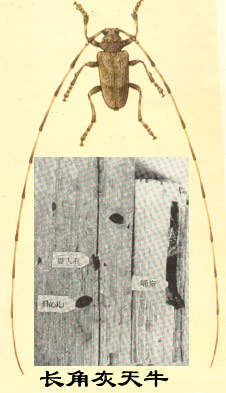Gray long-horned beetle (Gray long-horned beetle) is distributed in Heilongjiang, Jilin, Hebei, and Shandong in China, and is distributed in Europe, Siberia of the Soviet Union, and North Korea abroad. Damage to red pine and spruce. Red pine was the most severely affected.
Adult: Flat body, 12-21 mm long and 4-8 mm wide. The background color is brownish-red, either dark or thick, and is covered with gray hair that is not too dense, contrasting with the background color. The antennae are extremely long, and the ratio of body length to antennae is 1:3-5 for males and about 1:2 for females; they are covered with light gray hairs, and about 1/2 of the end of each segment is brown-red or dark brown-red. The lower edge of segments 3-5 in males is densely covered with pubescence; the surface of the antennal stalk is rough and slightly granular, and the 3rd segment is slightly longer than the stalk; in females, starting from the 3rd segment, each segment is almost equal or sequential The segments are shorter in sequence, with the distal segment being the shortest; in males, from the 3rd segment onward, each segment is slightly longer than the anterior segment, with the distal segment being the longest. There are many irregular transverse ridges on the pronotum, mixed with rough engraved spots; there are 4 brown or golden hair spots in the front of the middle, located on less obvious nodules, arranged in a horizontal row; side spines The base of the process is broad, the spine tip is very short, and slightly curved backward. There are two dark and slightly oblique horizontal stripes on each elytra, one in front of the middle and one at the end 1/3, with the latter being more prominent; the deep horizontal stripes are slightly arched, on each wing. There are also 2 or 3 longitudinal ridge lines that can be vaguely seen; the surface is densely covered with granular or granular engraved spots, especially at the base and shoulders; in addition, there are sparse small round spots, most of which are in the mid-slit area in the center of the wings; Wing ends blunt and rounded. The feet are quite stout, and the length of the first tibial section of the hind foot is approximately equal to the sum of the other three sections. The female ovipositor is exposed and very conspicuous; the fifth segment of the abdomen is slightly longer than the sum of segments 3 and 4, and the end is not sunken.

Larvae: Mature larvae are long and thin, with 8 bristly holes arranged in a row on their foreheads. There are 2-4 wide and separated longitudinal marks on the lip base. The antennae have 2 segments, the 2nd segment is rectangular and has a small conical transparent protrusion. There is a row of setae on the front edge of the prothorax. Behind the pronotum, there are two very rough and reddish-brown areas, with many scattered smooth spots. Not enough. Three anal fissures.
Biological characteristics: This insect has one generation per year and often overwinters as adults in the pupa chamber. In May of the following year, the adults bite an oblate emergence hole and emerge; in early June they lay eggs on recently dead or felled conifer trunks. Before laying eggs, a funnel-shaped notch is bitten into the bark of the tree, and then the ovipositing tube is perforated to deepen it. The larvae feed in the phloem, and by the end of summer, they burrow into the surface of the xylem and pupate. There are also a few that pupate in a pupa chamber under the bark. The pupation period is in late August or early September. After emerging, the adults often overwinter in the pupa chamber.
animal tags:
We created this article in conjunction with AI technology, then made sure it was fact-checked and edited by a Animals Top editor.